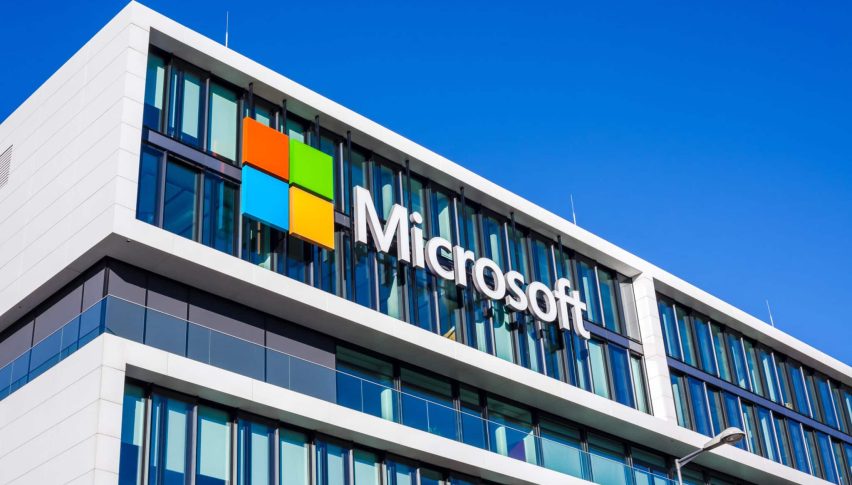Microsoft From Peak to Pressure: MSFT Stock Threaten Breakdown on Mounting Risks
As investors become increasingly concerned about growing AI costs, internal strife, and heightened competition, Microsoft's post-earnings...

Quick overview
- Microsoft's stock has dropped over 6% following a strong earnings report, signaling profit-taking and weakening investor confidence.
- Rising AI expenses and internal turmoil, including employee protests, are contributing to concerns about the company's long-term growth prospects.
- Despite surpassing revenue and earnings expectations, heavy investments in AI and OpenAI are straining profitability and raising doubts about sustainability.
- The company's cloud services continue to perform well, but increasing competition and operational risks are creating a more fragile outlook.
Live MSFT Chart
[[MSFT-graph]]As investors become increasingly concerned about growing AI costs, internal strife, and heightened competition, Microsoft’s post-earnings enthusiasm has swiftly subsided, with the stock falling below important support levels.
Rally Loses Steam After Earnings Highs
After a strong earnings report in late July sent Microsoft shares to record highs above $555, the excitement quickly evaporated. The stock has now fallen over 6% in just a few days, closing last week around $517 after failing to hold above its short-term moving averages. The loss of momentum suggests profit-taking and weakening confidence, with traders eyeing a potential pullback toward $468, the previous resistance level.
MSFT Chart Daily – Reversing Below the All Time High
On the weekly chart, the MSFT stock found support at the 20 SMA (gray) after the pullback from all time highs at $555. The stock started to rebound on Monday, but reversed and lost all the gains and then some more, retuning to the 20 SMA pretty fast. This price action shows that MSFT will likely break below the 20 weekly SMA next week and head lower.
MSFT Chart Weekly – Returning to the 20 SMA Quickly Points to A Bearish Break
The retreat accelerated after CFO Amy Hood warned that capital expenditure growth will accelerate, signaling more spending ahead — especially in AI infrastructure. While these investments fuel innovation, they are straining profitability and raising doubts about Microsoft’s ability to sustain its rapid expansion.
Microsoft Tops Q1 Estimates but Costs Trim Profit Margins
Headline Results
- Earnings per share (EPS): $3.72 vs. $3.67 expected
- Revenue: $77.67 billion vs. $75.33 billion expected
- Net income: $27.7 billion, up from $24.67 billion a year earlier
- Revenue growth: +18% year-over-year
Microsoft comfortably surpassed Wall Street expectations for both revenue and earnings, reflecting continued strength in cloud services and AI-driven enterprise demand.
OpenAI Investment Drags on Profit
- Microsoft’s heavy investment in OpenAI cut $3.1 billion from net income this quarter — about $0.41 per share.
- The charge highlights the high cost of maintaining AI leadership, even as it strengthens long-term positioning.
- Despite the hit, Microsoft’s profitability remains robust, showing resilience amid growing R&D and infrastructure expenses.
Cloud Remains the Core Growth Engine
- Intelligent Cloud unit revenue: $30.9 billion (+28% YoY), topping consensus of $30.25 billion.
- Azure growth: 38% — stronger than analyst estimates of 38.2%.
- Microsoft reported $75 billion in annual revenue from Azure and other cloud services, a 34% jump from the prior year.
- Azure’s performance reaffirms Microsoft’s dominant role in the AI-driven cloud market, challenging AWS and Google Cloud.
Outlook for Next Quarter
- For fiscal Q2 2025, Microsoft projects revenue between $79.5 billion and $80.6 billion.
- The midpoint, $80.05 billion, slightly exceeds the analyst forecast of $79.95 billion.
- Management expects cloud and AI integration to continue fueling enterprise demand, offsetting short-term cost pressures.
AI Schizophrenia Turns Costly and Competitive
Despite impressive gains in its cloud business, Microsoft’s insane commitment to AI is becoming a double-edged sword. The company’s deep partnership with OpenAI — once viewed as a major advantage — now appears riskier as OpenAI explores working with Broadcom to develop its own chips by 2026, potentially cutting reliance on Microsoft’s cloud infrastructure.
Adding to the unease, reports suggest OpenAI is considering launching a recruitment platform that could directly compete with LinkedIn, one of Microsoft’s key assets. The threat of internal competition within its own ecosystem highlights growing tension in the partnership and raises questions about long-term strategic alignment.
Security and Hardware Woes Compound the Pressure
Microsoft’s image as a reliable tech leader took another hit after a data leak exposed weaknesses in its AI systems. Security experts warn that sensitive internal chats could be used for cyberattacks, underscoring that even major AI players are not immune to operational risks.
Meanwhile, the Xbox division continues to struggle, with hardware sales down 29% year-over-year. Analysts note this decline was partly expected as the current console generation matures, but it still reflects fading consumer demand and limited new product momentum.
Internal Tensions and Public Scrutiny
Microsoft is also grappling with rising internal unrest. Employee protests at its Redmond headquarters have drawn attention to the company’s alleged ties to global conflicts. Demonstrations over civilian casualties in Gaza have intensified ethical scrutiny of Microsoft’s defense and AI contracts, adding reputational risk at a time when the firm is already under pressure.
Conclusion: Cracks Beneath the Revenue
Microsoft’s leadership in cloud remains undisputed, but cracks are forming beneath its polished growth narrative. Surging costs, competitive uncertainty, and internal friction are eroding investor confidence.
While long-term demand for Azure and AI tools is likely to persist, the combination of shrinking margins, public criticism, and rising operational risks paints a more fragile picture. Unless management reins in spending and restores confidence, Microsoft’s once unstoppable rally could give way to a sustained correction.
- Check out our free forex signals
- Follow the top economic events on FX Leaders economic calendar
- Trade better, discover more Forex Trading Strategies
- Open a FREE Trading Account




